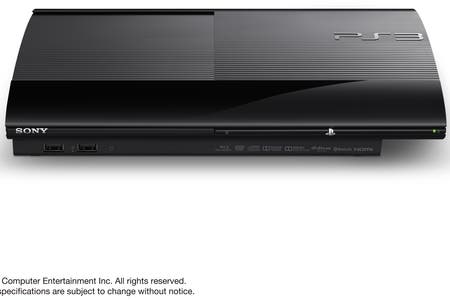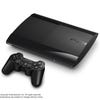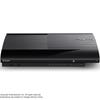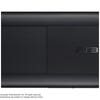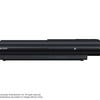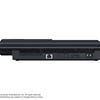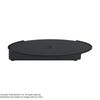Digital Foundry goes hands-on with the new super-slim PS3
The Blacksmith of the Future's take on the 500GB CECH-4000 console.
This new PlayStation 3 revision is going to be a highly controversial product. Sony has a fairly solid reputation for maintaining product quality as its consoles move through their lifecycles, usually managing to combine cost-cutting measures with enough in the way of cool, small, fresh ideas to produce enticing new takes on their existing hardware. But the new PS3 CECH-4000 bucks the trend somewhat: it's designed to be built to a budget, and it shows.
First impressions are intriguing once the unit is liberated from its surprisingly dinky packaging. It's very, very small, its modest presence diminished still further when placed side-by-side with the standard DualShock 3, and alongside an original launch model PS3 the extent of the overall shrinkage truly is quite remarkable. The new model is half the size and weight of the original PS3, and enjoys a drop of 25 per cent in volume and 20 per cent in heft compared to the Slim.
Despite the reduced dimensions, functionality remains the same as the existing model, with two USB ports, multi-AV, HDMI and toslink optical audio all present and correct. Additional materials out of the box are also a match for the Slim, meaning power and USB leads, composite AV cables with a SCART adaptor, but still no HDMI. Not to worry though, we picked up one of those from Poundland.
Despite an initial scare after a cursory inspection of the unit, the hard drive upgrade functionality of previous PS3 models thankfully remains intact. The right side - or the top, depending on orientation - can be removed in its entirety, revealing the familiar hard drive bay with its signature bright blue screw-head. The 500GB model supplied to us by Sony appears to be using an off-the-shelf 5400rpm unit from Hitachi, and there should be no issue in upgrading the unit with virtually any 2.5-inch drive you fancy. Sony is also launching a 12GB model based on flash memory, with a 250GB hard drive add-on available to expand it. We'll be taking a closer look at this arrangement once the new model is available for review.
"Functionally identical to the existing Slim, the new PS3 is remarkably small unit with solid build quality but let down a touch by cheaper plastics and a disappointing sliding drive cover."
In most other respects, the unit lacks much in the way of distinguishing features, save the appearance of PlayStation branding on the left/bottom of the case. This logo takes the form of a plug recessed into the side of the casing, and pried loose it reveals a solitary screw hole. It's here that the optional stand for the new model is attached.
Construction of the CECH-4000 model is clearly somewhat simpler compared to its predecessors, and the quality of the materials used feels like a bit of a step down compared to the current PS3 Slim. There's a mixture of fingerprint-attracting glossy plastics on the oval top, while the ridged sliding drive bay cover is matte in nature and somewhat cheap-looking for a PlayStation product. The aesthetic of the PS3 has been defined by its sweeping curves and quality feel - this 'corrugated' lid arrangement doesn't just look a little cheap, it just feels out of place compared to the premium finish previous PS3 models have enjoyed.
The sliding drive bay cover itself is most definitely the weakest element of the new model in terms of build quiality. When removing the unit from the packaging, the cover itself is held in place with a small piece of blue protective tape. Gently peeling this back immediately caused the cover to spring open across the face of the unit, which was a little startling.
There's an eject button alongside the power button on the front of the unit (arranged via a kind of 'rocker' switch, and again lacking a premium feel), but the clasp that holds the drive cover in place as your games play is fairly weak and is easily opened by hand, making the button itself seem somewhat superfluous. The drive cover is the one weak link in what is otherwise a sound piece of engineering: there's no heft or smooth motion to the lid as it moves across the face of the console. It feels somewhat makeshift and even rattles a little it moves across.
Binning the slot-loading drive for a mechanical alternative is a no-brainer in terms of reducing build cost, and the slidey cover solution is a nice idea for preserving the traditional shape of the console without reverting to a PSone/Dreamcast-style top-loader. However, the physical implementation of the concept just feels a little too cheap and somewhat at odds with other parts of the console, which must have added significantly to the overall bill of materials - such as the in-built power supply, for example.
"Fan whirr is mostly a non-issue in a living room environment, but at close quarters it is definitely noticeable. Spinning up a Blu-ray game is more of the same - audible, but not unduly annoying."
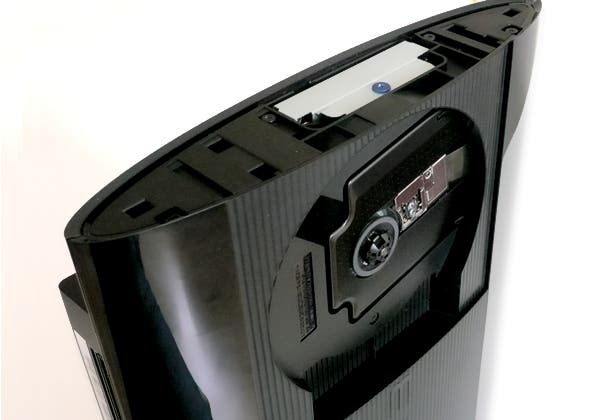
Connecting up the new unit and powering it up proves to be the surprise-free process we hoped it would be. Certainly in terms of XMB access, response, controller syncing, WiFi speeds and 3D support, this new PlayStation 3 appears to be a complete match from a functionality perspective to the existing model - no better, no worse. However, while quiet during front-end navigation and media playback, it's definitely not silent. Fan whirr is mostly a non-issue in a living room environment, but at close quarters it is definitely noticeable. Spinning up a Blu-ray game is more of the same - audible, but not unduly annoying. On our unit at least, drive noise seemed to be increased over our in-house launch PS3 units. Increased noise from the drive on the latest model is to be expected bearing in mind that the disc is now behind a thin piece of plastic as opposed to running inside an enclosed unit.
We've only had this unit for a day now and we've yet to put it through the extensive testing we carried out when our PS3 Slim first arrived - we're interested to see what kind of power draw the revised model takes from the mains, and to put the revised BD drive through some more rigorous testing. We'd also quite like to get a good look at the internals of this new revision, specifically to discover whether Sony has managed to integrate Cell and RSX into a single chip, as it did on its ultra-slim PS2 offerings. The firm has done this before with the PS2 Slim, which merged the Emotion Engine and the Graphics Synthesizer into one cut-price silicon package - a strategy adopted by Microsoft with much success on the 360S.
Going forward, it's the ability to market the PS3 at a reduced price point that makes this model so important to Sony. At the moment, this 500GB SKU appears to be attracting a price just above a 320GB Slim bundled with a game or two. As things stand, unless we were really pressed for physical space, we'd take the hit on HDD space in exchange for the build quality and the freebie software of the older model. However, looking to the future, this new model forms the basis of Sony's ability to aggressively reduce RRPs to better take on the Xbox 360; if it genuinely cut prices and tossed in a three-month trial to PlayStation Plus, with its tremendous instant games collection, we'd have the makings of a truly competitive package.
